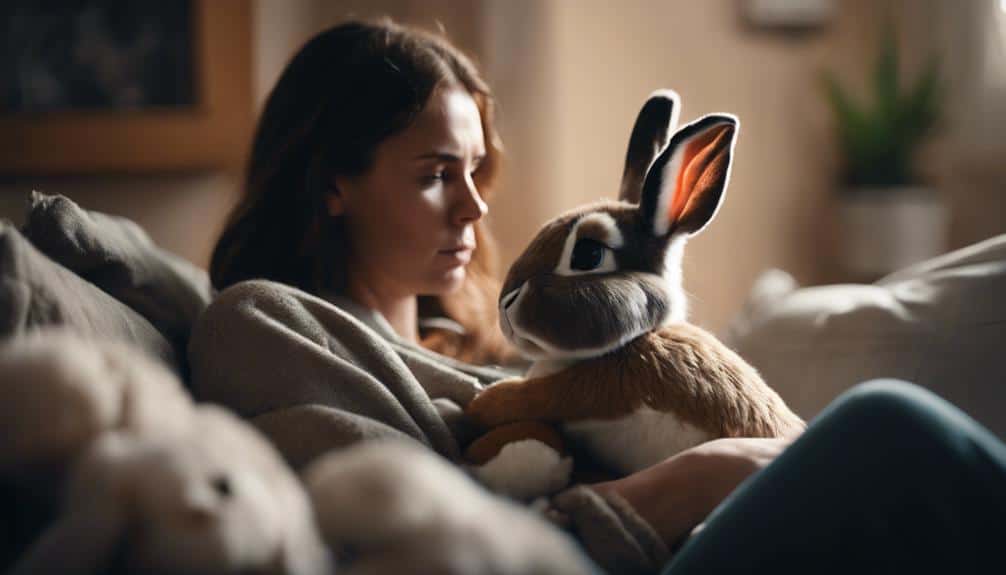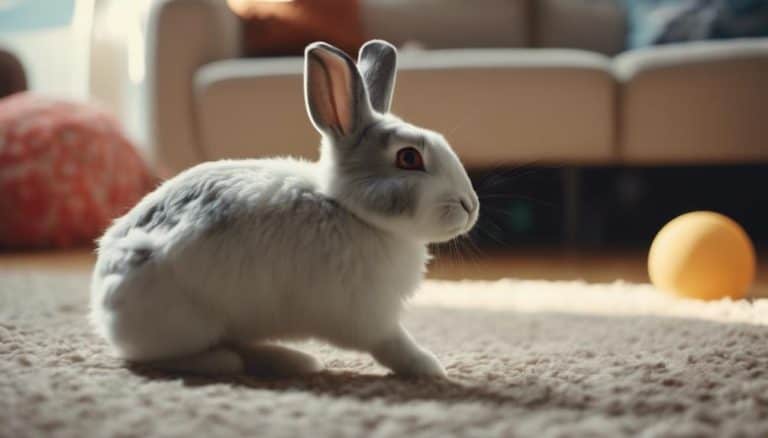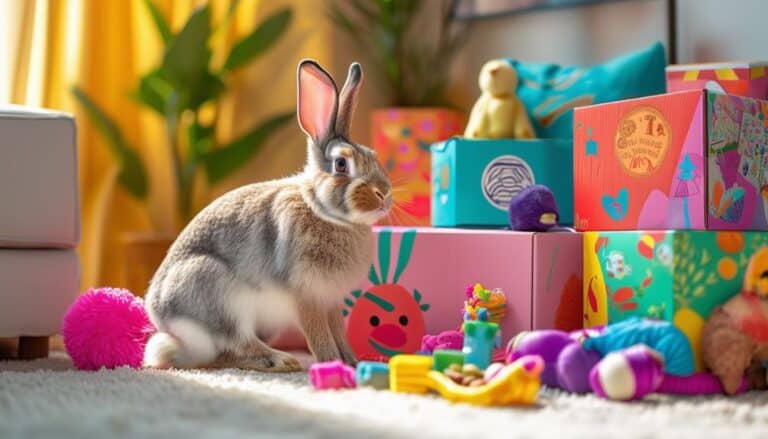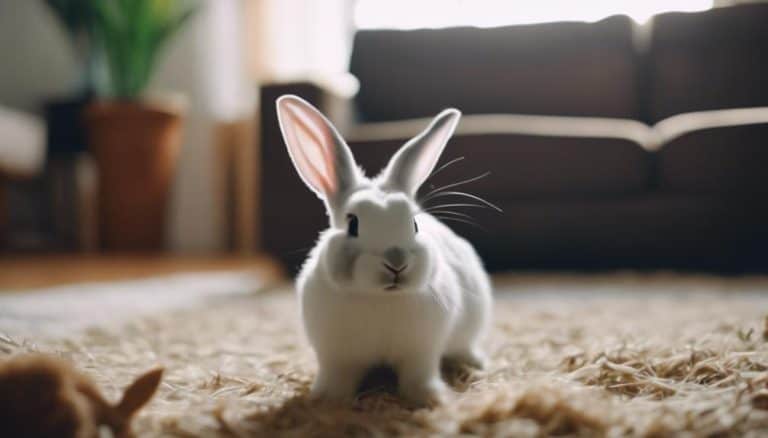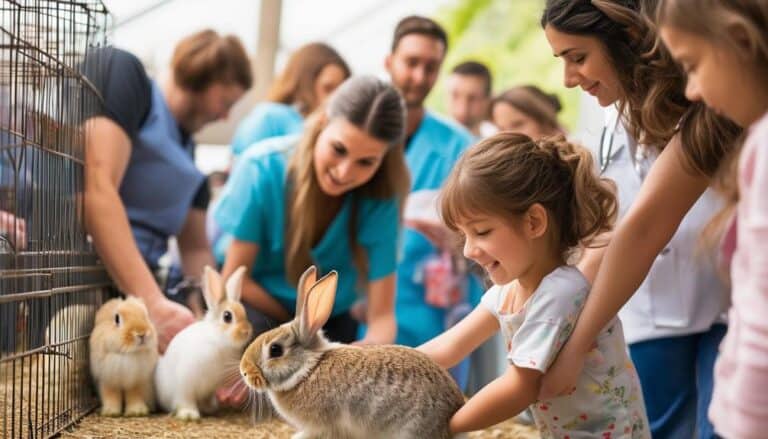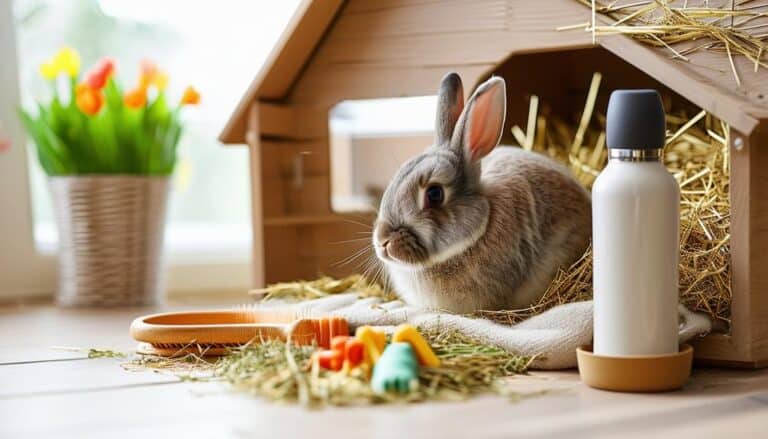Understanding and Addressing Your Pet Rabbit's Grunting
Understanding your pet rabbit’s grunting is essential for fostering effective communication and a strong bond.
You might notice these vocalizations more often during specific activities, like feeding or playtime, which can tell you a lot about their emotional state. But what exactly does each grunt mean? It’s not just about the sound; context and accompanying body language play significant roles too.
By recognizing these cues, you can better meet your rabbit’s needs and guarantee their well-being. Ready to decode your rabbit’s grunts and create a more harmonious relationship? Let’s explore the deeper meanings behind these sounds.
Identifying Grunting Sounds
Recognizing the distinct characteristics of rabbit grunting sounds is vital for accurate interpretation of their communication. When your rabbit emits short, deep, and harsh vocalizations, they’re likely grunting. These sounds can be repeated multiple times, each repetition potentially indicating different emotions or needs. It’s important to note that a rabbit’s grunting isn’t just random noise; it’s a deliberate form of communication.
By focusing on the cadence and frequency of these grunts, you can begin to understand your rabbit’s messages. For example, a series of rapid grunts might signal distress or excitement, while more spaced-out grunts could indicate curiosity or mild displeasure.
To accurately interpret these grunts, you should also pay attention to your rabbit’s body language. Ears pinned back, tense posture, or rapid movement can provide context to the vocalizations, offering valuable insights into their feelings or intentions. Conversely, relaxed ears and a calm demeanor paired with grunts might suggest contentment or affection.
Contexts of Grunting
Understanding the contexts in which your rabbit grunts can greatly enhance your ability to interpret their communication accurately. Recognizing that rabbits grunt for various reasons, and the context in which these sounds occur can provide significant insights.
During feeding times, a rabbit’s grunting often reflects enthusiasm or excitement for food. This behavior indicates anticipation and can be a sign of a healthy appetite. When rabbits grunt while approaching or interacting with you, it usually denotes affection or anticipation of positive interaction. These contexts suggest a bond between you and your pet.
Carefully observing the context in which grunting occurs is vital. If a rabbit grunts while displaying particular body language, such as a relaxed posture or active engagement, it often points to positive emotions. Conversely, grunting accompanied by defensive or aggressive postures may signal discomfort or irritation.
Each rabbit exhibits unique grunting patterns, so paying attention to individual behaviors is important. These patterns, when observed consistently within specific contexts, can provide valuable cues about your rabbit’s emotional state. By understanding these contexts, you can foster a more harmonious and responsive relationship with your pet rabbit.
Emotional Cues
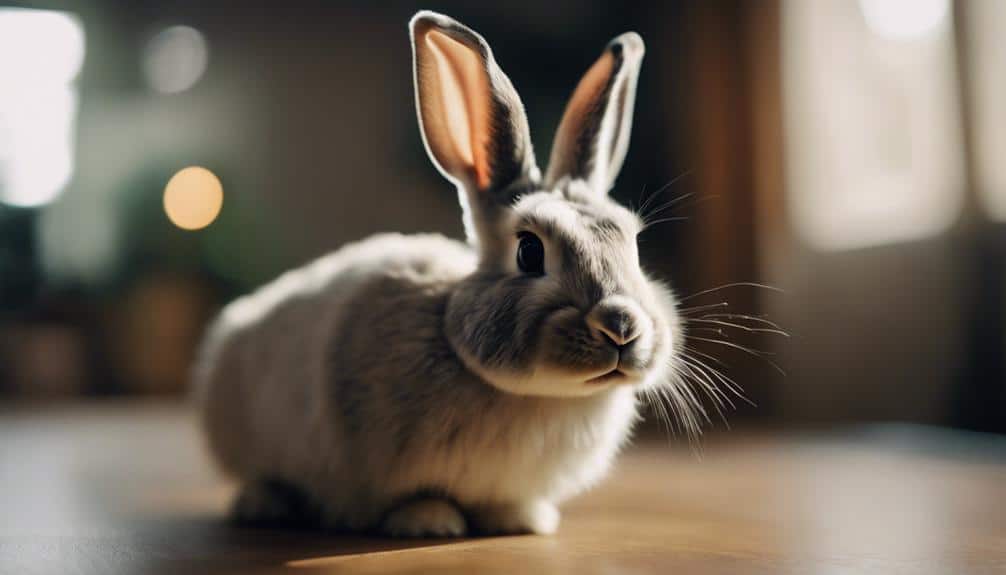
By paying close attention to your rabbit’s grunting in various contexts, you can start identifying the emotional cues these sounds convey. Rabbit grunting can signify a range of emotions, from happiness and excitement to displeasure. For instance, grunting during feeding time often indicates enthusiasm for food, while grunting when approached may signal affection. By observing these patterns, you can better interpret your rabbit’s grunts and respond appropriately.
Understanding these emotional cues helps you meet your rabbit’s needs more effectively, thereby fostering a stronger bond. Here’s a table to help you interpret various grunting scenarios:
| Context | Possible Emotion | Interpretation |
|---|---|---|
| Feeding Time | Enthusiasm | Your rabbit is excited for food. |
| When Approached | Affection | Your rabbit enjoys your presence. |
| During Play | Happiness | Your rabbit is having fun. |
| When Restrained | Displeasure | Your rabbit feels restricted. |
| When Ignored | Attention-Seeking | Your rabbit wants interaction. |
Body Language Indicators
To fully comprehend your rabbit’s grunting, you must also consider their body language indicators.
Pay close attention to ear position signals and tail movements, as these can provide critical insights into their emotional state.
Ear Position Signals
Monitoring your rabbit’s ear positions provides valuable insights into their emotional state and intentions. Understanding these signals can greatly enhance your ability to communicate with your pet. When your rabbit holds its ears back against its body, it often indicates fear, stress, or discomfort. Recognizing this posture is important for addressing any underlying issues that may be causing distress.
Conversely, if your rabbit’s ears are both forward, this typically signals alertness, curiosity, or interest in their surroundings. This posture suggests they are happy and engaged. On the other hand, one ear forward and one ear back can be interpreted as a sign of caution or divided attention, indicating that your rabbit is processing multiple stimuli at once.
Here’s a quick reference table to help you understand these ear positions better:
| Ear Position | Emotional State/Intention |
|---|---|
| Ears back | Fear, stress, discomfort |
| Both ears forward | Alert, curious, interested |
| One ear forward, one back | Caution, split focus |
Tail Movements Meaning
Just as understanding ear positions can reveal your rabbit’s emotional state, tail movements provide vital insights into their feelings and intentions. Observing your rabbit’s tail can help you decode their non-verbal cues, making sure you respond appropriately to their needs.
When your rabbit’s tail is held high, it’s a sign of excitement or alertness. This posture indicates they’re highly engaged with their environment and ready to interact.
Conversely, tail flicking often signals annoyance or agitation. If you notice this behavior, it’s best to give your rabbit some space to calm down.
A tucked tail can indicate fear, discomfort, or submission. If your rabbit’s tail is tucked, they may feel threatened or be in an unfamiliar, intimidating situation. Make sure their environment is safe and comforting to alleviate their stress.
Rapid tail wagging, though less common, can signal aggression or territorial behavior. This intense movement demands immediate attention, as your rabbit may feel the need to defend their space.
Understanding your rabbit’s tail movements is essential for interpreting their emotions and intentions. By recognizing these non-verbal cues, you can create a more harmonious relationship with your furry companion, fostering an environment where they feel secure and happy.
Grunting During Feeding
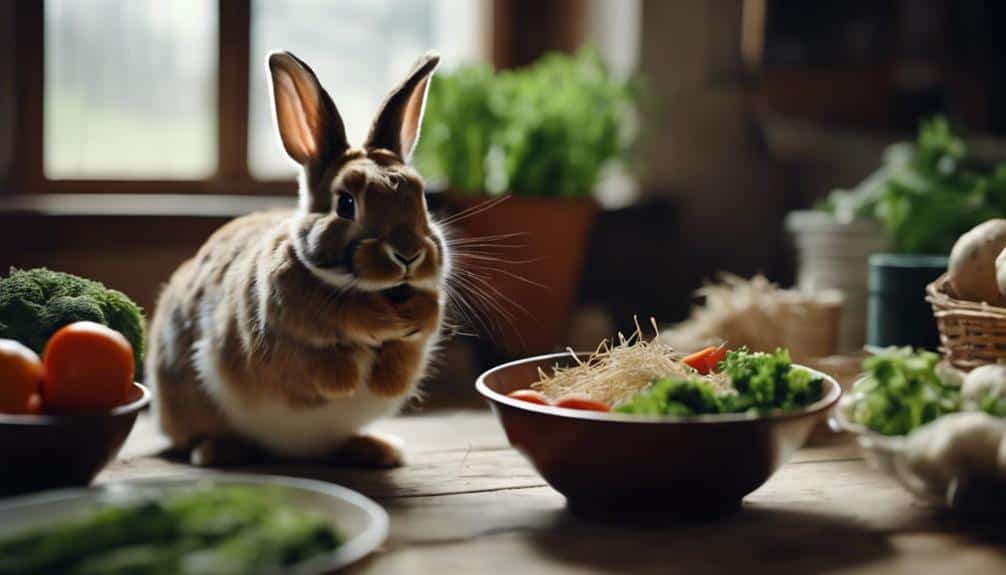
When your rabbit grunts during feeding, it often signifies their enthusiasm and excitement for the meal. This behavior is a positive expression of joy, demonstrating your pet’s keenness for their favorite treats. Understanding these vocalizations can enhance your bond with your rabbit and optimize their feeding experience.
Here’s what to look out for:
- Intensity of Grunting: Softer grunts typically indicate mild excitement, whereas louder, more frequent grunts may signify heightened anticipation.
- Body Language: Observe if your rabbit’s posture is relaxed or tense. A relaxed posture with a steady, rhythmic grunting often indicates contentment.
- Feeding Context: Pay attention to the specific foods that elicit grunting. Identifying these can help tailor your rabbit’s diet to include their most-loved treats.
- Frequency: Consistent grunting during feeding times can be a reliable indicator of your rabbit’s general happiness and well-being.
Grunting During Play
You’ll notice that your rabbit might grunt during play as an expression of their excitement and joy. This behavior is a positive indicator of your rabbit’s emotional state, akin to the purring of a content cat.
When your rabbit engages in playful activities such as chasing or tossing toys, grunting can signal their happiness. Additionally, you’ll observe that these grunts often accompany behaviors like binkying—joyful leaps and twists in the air—and zooming around.
Understanding these playful grunts helps you better interpret your rabbit’s emotional cues. Just as rabbits purr by grinding their teeth softly when relaxed, grunting during play is another way they communicate their feelings. It’s essential to recognize these signals to foster a deeper bond with your pet.
Human-Rabbit Interactions
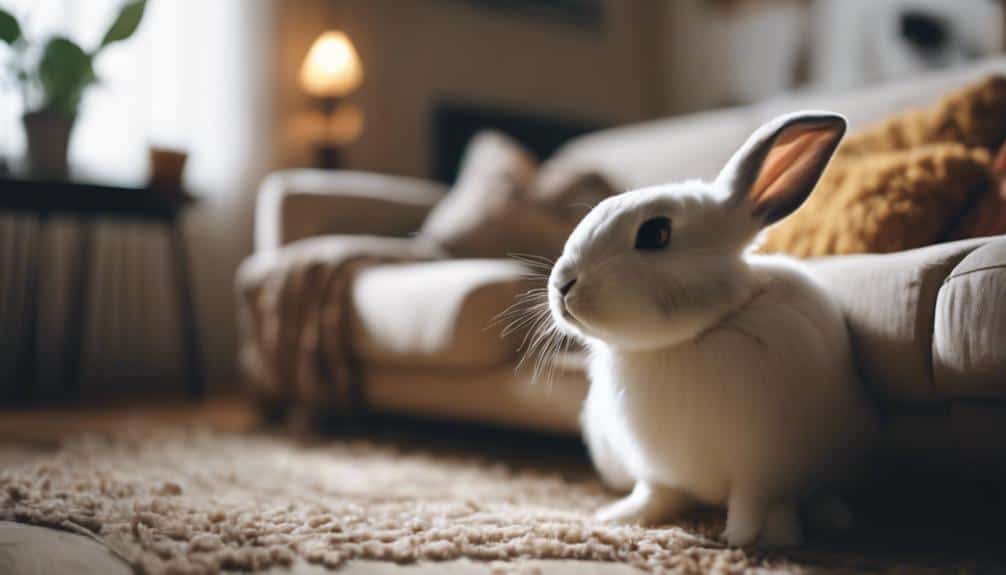
When interacting with your rabbit, recognizing grunt cues is essential for understanding their emotions and building trust.
Effective communication techniques, such as observing their body language and responding appropriately, can greatly enhance your bond.
Recognizing Grunt Cues
Recognizing your rabbit’s grunt cues involves interpreting both vocalizations and body language to accurately gauge their emotional state and needs. When your rabbit makes these sounds, it’s important to take into account the context to determine whether they’re expressing eagerness, affection, or even signs of pain. Here’s how you can identify and interpret various grunting cues:
- Feeding Time Excitement: Grunting during feeding often indicates your bunny’s enthusiasm for food, signifying a positive mealtime interaction.
- Affection and Attention: If your rabbit grunts when approached, they might be seeking affection or attention, strengthening your bond.
- Contextual Interpretation: Always analyze the situation; different contexts can evoke different emotional responses, so observe the entire scenario.
- Body Language Correlation: Combine vocal cues with body language to get a more thorough understanding of your rabbit’s intentions.
Building Trust Together
Establishing a foundation of trust with your pet rabbit requires consistent, gentle interactions and a keen understanding of their behavioral cues. Regular grooming sessions not only help you monitor your rabbit’s health but also strengthen your bond.
When your rabbit grunts, accurately interpreting this form of communication is crucial. Grunts can indicate discomfort or agitation, so responding appropriately can alleviate their stress and build trust.
Pay attention to your rabbit’s body language. Signs like relaxed ears and a calm posture often suggest that your rabbit feels safe. Conversely, tense muscles or rapid movements may indicate fear or discomfort. By observing these cues, you can adjust your interactions to create a more comforting environment for your rabbit.
Promptly responding to your rabbit’s needs fosters a sense of security and comfort. This responsiveness shows your rabbit that you’re a reliable and caring companion. Creating a safe, comforting environment encourages a happy and healthy relationship, making your rabbit more open to positive interactions.
Incorporating these practices into your daily routine will enhance your communication with your rabbit, ultimately leading to a stronger, more trusting bond.
Effective Communication Techniques
Understanding effective communication techniques with your rabbit involves closely observing their body language and vocalizations to interpret their grunting behavior accurately. Recognizing these cues allows you to respond appropriately, fostering a stronger bond.
When communicating with your rabbit, follow these evidence-based practices:
- Observe Body Language: Pay attention to subtle cues such as ear positioning, teeth grinding, and posture. A relaxed rabbit will have a different stance compared to a stressed one.
- Listen to Vocalizations: Grunting isn’t the only sound rabbits make. Whimpering or growling can also inform you about their emotional state.
- Use Positive Reinforcement: Reinforce desired behaviors using treats and praise. This technique can help your rabbit associate communication with positive outcomes.
- Maintain Consistency: Establish clear communication cues by being consistent with your interactions. This helps your rabbit understand and predict your responses.
Avoid sudden movements or loud noises during communication sessions, as these can startle your rabbit and disrupt the interaction.
Building a strong bond through regular, gentle interactions ensures your rabbit feels secure and understood.
Strengthening Your Bond
Monitoring your rabbit’s vocalizations and grooming them regularly enhances communication and builds a stronger bond. By paying attention to these vocal cues, you can better understand your rabbit’s needs, fostering a more responsive and empathetic interaction. Grooming sessions not only keep your rabbit healthy but also provide a valuable opportunity for physical contact and trust-building.
Responding promptly to your rabbit’s needs is vital. When your rabbit exhibits signs of distress, addressing them immediately not only alleviates discomfort but also reinforces your role as a caregiver, strengthening your bond. This responsiveness helps in creating a secure environment, essential for your rabbit’s well-being.
Additionally, understanding your rabbit’s unique behavioral patterns and preferences can greatly enhance your communication. For instance, recognizing when a grunt indicates discomfort versus excitement enables you to tailor your responses appropriately. This nuanced understanding fosters deeper trust and a more harmonious relationship.
Ensuring a safe and enriching environment where your rabbit feels secure and content is paramount. Regularly check for potential hazards and provide stimuli that cater to their physical and mental needs. By doing so, you promote a happy, healthy pet and a more fulfilling companionship.
Conclusion
By attentively observing your rabbit’s grunting and associated body language, you’ll gain valuable insights into their emotions and needs. Recognize the nuances in their vocalizations and contexts to address concerns effectively.
Through consistent, gentle interactions and positive reinforcement, you can foster a trusting and enriching environment for your rabbit. This evidence-based approach not only enhances communication but also strengthens the bond, ensuring your rabbit’s well-being and happiness.

